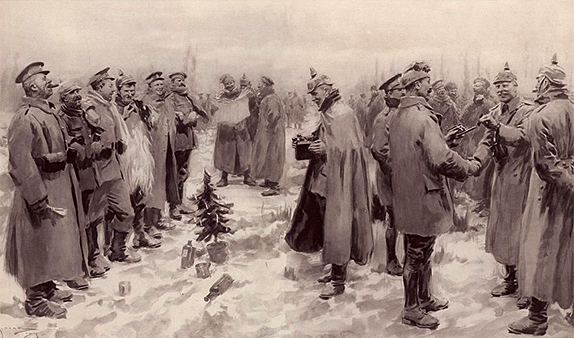
A century ago on the holiday’s eve, weeks of miserable rain gave way to the stillness of a freeze. Tiny ice crystals held the earth, and, with the sun long retired, warm breaths condensed into motion.
“English soldier, English soldier, a merry Christmas, a merry Christmas!” Frederick Heath, a British private, wrote in a letter home as he remembered hearing the greeting in his trench along the Western Front. “Come out, English soldier; come out here to us.” Heath’s 1914 letter continues describing what is known as the First World War’s Christmas Truce:
“For some little time we were cautious, and did not even answer. Officers, fearing treachery, ordered the men to be silent. But up and down our line one heard the men answering that Christmas greeting from the enemy. How could we resist wishing each other a Merry Christmas, even though we might be at each other’s throats immediately afterward? So we kept a running conversation with the Germans, all the while our hands ready on our rifles. Blood and peace, enmity and fraternity—war’s most amazing paradox. The night wore on to dawn—a night made easier by songs from the German trenches, the pipings of piccolos and from our broad lines laughter and Christmas carols. Not a shot was fired.”
With 400 miles of trenches along the Western Front, multiple versions of the impromptu Truce exist. Many wrote they reluctantly emerged from their damp ruts disobeying their superior’s orders and walked into no man’s land. From France across Flanders, soldiers greeted each other and exchanged goods. They buried the dead. Newspapers ran accounts of a soccer match, and pictures show posed men from opposing sides next to one another in each other’s uniforms. These were the moments of humanity played out by ordinary people in one of the deadliest scenes from the twentieth century.
The Truce, however, was short lived. The men returned to their designated trenches, and, with their constructed identities and perceived duties, they took up their weapons again. The conclusion of Heath’s letter captures the temporary peace. “As I finish this short and scrappy description of a strangely human event, we are pouring rapid fire into the German trenches, and they are returning the compliment just as fiercely. Screeching through the air above us are shattering shells of rival batteries of artillery. So we are back once more to the ordeal of fire.”
Now when they followed orders, the soldiers shot at ordinary people who had a face, a voice, a name they knew.
The next truce on the Western Front came four years later in the form of the November 1918 armistice, but, by that point, nearly 30 million people had been killed or wounded in the war, and the fate of the letter’s author remains unknown.
In its simplicity, the Christmas Truce shows an often-avoided truth: war is a choice. It is not an unavoidable catastrophe. If ordinary people collectively chose to lay down arms, suspend hostilities, and forget duties, they can stop the chaos and absurdity of war in favor of peace and sanity.
One hundred years later, wars are still mass acts of violence committed by ordinary people, like Heath. They organize through learned identities of nationality, religion, and race. Then, they receive orders and, through freewill, commit heinous acts of violence. While euphemisms of prestige, protection, and progress, disguise the disaster of war, at its most basic level, war remains simple: ordinary people give the orders, ordinary people build the murderous technologies, ordinary people pull the triggers, and ordinary people drop the bombs.
As the world stands on the eve of 2015, imagining ordinary people giving up their roles in war—even for a day—is difficult, but the premises promoting war today do not diverge from the ones that existed on the eve of 1915. The soldier learns about the enemy’s barbaric tendencies, and he seeks revenge, whether it is idealistic, personal, or petty. Military officials invest themselves professionally in the chain of command giving and executing orders from behind the front lines. Engineers and specialists design and build weapons to kill; then, they go home to families. Business people and contractors pocket fortunes of public money and war loot in the fog of conflict. And, civilians retain thinking that allows them to stand by passively as war occurs—the lives of children at home are worth more than the lives of children elsewhere, individuals in other places deserve what they are enduring, and, the false premise of all wars, the improved ends will justify the ugly means of mass acts of violence.
Whether it is 1914 or 2014, the value to promote war, whatever the given social role, is a habit of obedience. It is the tendency to avoid thinking about what one is told to think and what one is told to do. The habit is instilled from an early age as staying in line, avoiding challenges to authority, and following directions expeditiously is rewarded with praise, status, and fortune.
During the pervious century, war increasingly requires a complex division of labor, so the habit of obedience is compounded by a dispersion of responsibility. People following directions excuse their actions because the responsibility for the mass acts of violence falls on no one. The soldier derives honor from following orders, not thinking about them. The military official believes in the chain of command, the purpose of war, the professional promotions. The engineer and businessperson take the profits of war to the bank, but they neither choose the enemy nor give the orders to use the weapons. The politician promotes the evil as a necessity sacrifice while cashing in on the political capital as has been done many times before. And again, the public, no matter its views on the specific war, quietly pays tribute to the complex system through obligatory taxes and social norms.
The responsibility for any action in war becomes dispersed in an abstract cloud of people and motives, an unintelligible map of society that only bits can be focused on at any one time.
This combination—a habit of obedience and the dispersion of responsibility—creates a paralysis of morality and will in each person supporting the war. If one’s obedient act is ever considered, it is clouded by the infinite dispersion of responsibility. The war continues with everyone supporting while thinking he or she is not the perpetrator of the mass act of violence.
A modern truce seems farfetched, but the current state of affairs remains even more difficult to imagine. Ordinary people are draining lives and fortunes into a system that murders, tortures, and degrades humans. Ordinary people are working to uphold an economy designed to fund war, and, when the available resources fall short, ordinary people mortgage a future generation’s dreams and desires in an inconceivable debt. Ordinary people, who after over a decade of wars, warnings, and reports, march the war machine forward leaving issues of health, education, and poverty—all in desperate need of public funding—unresolved. Maybe, compared to the current state, a brief peace seems possible.
A century after the Christmas Truce, war’s most amazing paradox remains; the belief that acts of mass violence yield safety and human progress. While the mission and enemy has changed—and will continue to change—the commonality of ordinary people committing heinous crimes against humanity remains. But, as it did 100 years ago with Frederick Heath, the first step towards peace begins with nonparticipation.



Responses to “The Christmas Truce 100 Years Ago and Today”